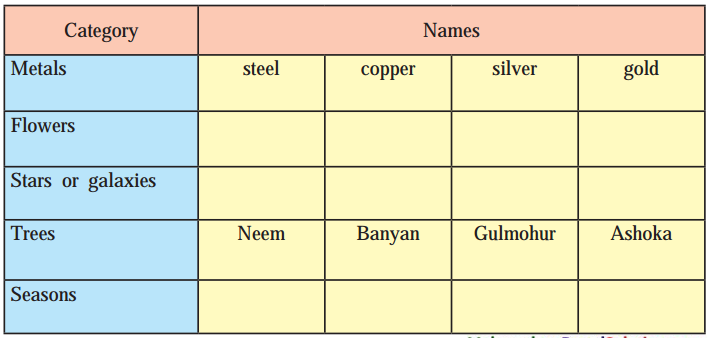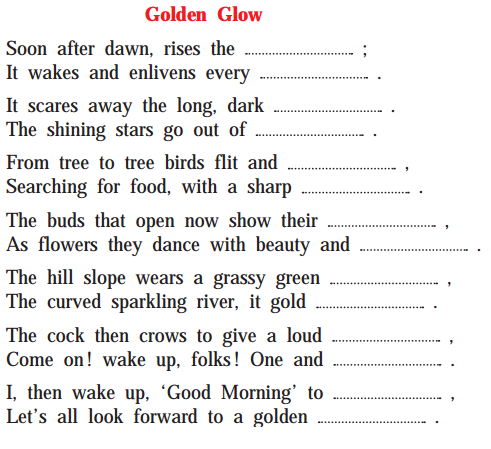Balbharti Maharashtra State Board Class 9 English Solutions Kumarbharati Chapter 3.1 Silver Notes, Textbook Exercise Important Questions and Answers.
Class 9 English Chapter 3.1 Question Answer Maharashtra Board
Silver 9th Std Question Answer
Warming Up:
Question 1.
Imagine that your class has to be divided into groups or houses. Each house will have their own colour, symbol/emblem, motto, dress code, a common room with objects of their interest and suitable furniture. Think of sets of four names for the groups. Form groups and work out the (imaginary) details for each set. Some suggestions are : Neem – Colour, yellow; Symbol, the sun; Motto, ‘Health is wealth’; Dress code, yellow waist belt; etc. Cane furniture, green and yellow curtains and herbariums in the common room.

Answer:
Example:
- House name – Banyan
- Colour – Green
- Symbol – the Moon
- Flower – Sunflower
- Season – Summer
- Metal – Copper
- Dress Code – Scarf with ‘Save the Environment’ slogan on it
- Special interests – Activities dealing with Environmental Pollution
- Motto – Save the Environment.

2. Read the lines of the following poem. Guess and fill in suitable words to make the lines rhyme:

Question 1.
Read the lines of the following poem. Guess and fill in suitable words to make the lines rhyme :
Answer:
Golden Glow:
Soon after dawn, rises the
sun
;
It wakes and enlivens every
one
.
It scares away the long, dark
night
.
The shining stars go out of
sight
.
From tree to tree birds flit and
fly.
Searching for food, with a sharp
eye
.
The buds that open now show their
colour
,
As flowers they dance with beauty and
splendour
.
The hill slope wears a grassy green
dress
,
The curved sparkling river, it gold
possess
.
The cock then crows to give a loud
call
,
Come on! wake up, folks! One and
all
.
I, then wake up, ‘Good Morning’ to
say
,
Let’s all look forward to a golden
day
.

English Workshop:
Question 1.
If you were asked to draw a detailed picture of the scene described in the poem, what objects, animals, natural features, etc. will you show in the picture? Make a list.
Answer:
I would show the following in my picture : moon, trees, fruits, the night sky, a house with a thatched roof, a dog in a kennel, doves in their dovecotes, a mouse, a stream, fish and reeds.
Question 2.
Write the rhyming words and rhyme scheme of the poem.
Answer:
Rhyming words are : moon – shoon, sees – trees, catch – thatch, log – dog, peep – sleep, by – eye, gleam – stream. The rhyme scheme is aa, bb, cc, and so on in rhyming couplets.
Question 3.
Underline the word silver/silvery in the poem. In what lines does it occur? What pattern S does it show?
Ans.
The word silver/silvery occurs in the second | line of every couplet. It shows a pattern of repetition for pleasing effect. (A couplet is a pair of successive lines of verse, which are usually of the same length, and rhyme.)
Question 4.
Can you think of a parallel scene of dawn or evening when everything is steeped in golden light?
Answer:
Yes, I can think of a seaside scene, with the setting sun throwing golden light over everything.

Question 5.
The same landscape appears different at different times. What message can we draw from this?
Answer:
The landscape changes according to the light from the sky. In this poem, the poet makes us look at ordinary moonlight in a different way. The message we can draw from this is how, in different situations, we might perceive the same scene completely differently.
Question 6.
Read ‘The Listeners’ and ‘Someone’ – poems by Walter de la Mare.
English Kumarbharati 9th Digest Chapter 3.1 Silver Additional Important Questions and Answers
Simple Factual Activity:
Question 1.
Which of the objects, animals, etc. mentioned in the poem are at rest without any motion?
Answer:
1. The objects that are at rest without any motion : trees, casements, thatch, kennel, cote, water.
2. The animals that are at rest without any motion : dog, doves, fish.

Complex Factual Activities.
Question 1.
How has the harvest mouse been described?
Answer:
The moonlight reflects on the eye and claws of the harvest mouse, making them look silvery. The mouse is running somewhere quickly.
Question 2.
How has the poet described the scene near the stream?
Answer:
The stream is gleaming with silver light. The fish in the stream are motionless and shining. There are silver reeds near the stream.
Question 3.
The poet has described a countryside scene. What tells you this?
Answer:
The poet talks about the moonlight falling on fruits, trees, thatched houses, a dog in the kennel, doves, a harvest mouse, reeds and streams with fish. All this will be present only in the countryside and not in cities.
Activities based on Poetic Devices.
Question 1.
Explain the figure of speech ‘Personification’ j in the first two lines.
Answer:
In these lines, the moon is personified. She is i given the human quality of walking in her silver shoes.

Question 2.
Give one example of Alliteration from the poem.
Ans.
‘By silver reeds in a silver stream.’ The sound of the letter ‘s’ is repeated.
Appreciation of Poem.
Note: The point format given in Appreciation of Poem is for easy understanding. However, it is to be written in the form of a paragraph in the examination.
Point Format(for understanding).
- Title: Silver
- Poet: Walter de la Mare
- Rhyme Scheme: aa, bb, and so on (rhyming couplets).
- Figures of Speech: Personification. ‘This way and that she peers and sees’. The moon is given the human quality of peering this way and that. The other figures of speech are Alliteration and Repetition.
- Theme/Central idea: The poet describes the magical effects of the silvery moonlight on the countryside at night, and shows a beautiful and | peaceful scene of the countryside at night under the moonlight.

Paragraph Format:
The poem ‘Silver’ is written by Walter de la Mare.
The rhyme scheme is aa, bb and so on. The poem is in rhyming couplets, i.e., two lines rhyming with each other. Personification is a Figure of Speech used by the poet: ‘This way and that she peers and sees’. The moon is given the human quality of peering this way and that. The other figures of speech are Alliteration and Repetition.
In this poem the poet describes the magical effects of the silvery moonlight on the countryside at night. Everything turns silver. The poem also shows a beautiful and peaceful scene of the countryside at night under the moonlight and gives a clear word picture of the different animals and objects reflecting the moonlight.